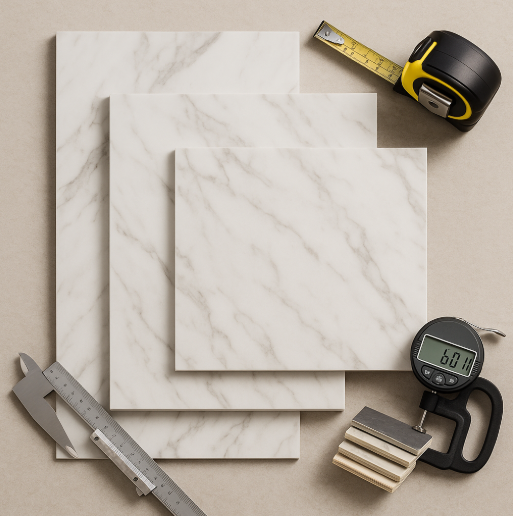Table of Contents
The first time I shopped for PVC marble sheets, I walked into the warehouse with a tape measure and walked out with humble pie. I’d measured my bathroom wall at 94 inches, ordered a standard 4×8 sheet because “that’s what everyone buys,” and only realized back home that 96 inches on paper doesn’t equal 96 inches of real coverage once you trim, square, and scribe. I shaved off a quarter inch to fit around a slightly crooked ceiling line and poof my perfect coverage wasn’t perfect anymore. That one mistake sent me down a rabbit hole about sizes, thickness, and grades. Here’s the no-drama version of what I learned, told the way I wish someone had told me: in a warm, practical voice, with real examples and the little decisions that actually change how your project turns out.
Start With the Room’s Truth, Not the Product Page
Before you look at a single SKU, stand in the room and say out loud what the wall needs to survive. A shower wall lives in steam and hot water. A kitchen backsplash wears oil freckles and coffee sneezes. A living room feature wall mostly deals with light and fingerprints. A cafe counter gets kicked by shoes, skimmed by bags, and cleaned every hour. When you name the room’s truth, you stop shopping like a gambler and start shopping like a builder. You’ll know whether fewer seams matter more than easier handling, whether you need a sturdier core, and whether that “premium topcoat” is marketing or exactly what keeps the wall looking like day one after month twelve.
Sheet Sizes: Why Bigger Isn’t Always Better
Most suppliers carry a familiar family of sizes: roughly 1220×2440 mm (4×8 ft), sometimes 1220×2800 mm (4×9 ft), and 1220×3050 mm (4×10 ft). There are also “half sheets” around 600×2440 mm for smaller runs. Here’s how those numbers feel in real life.
In a bathroom, the jump from 8 feet to 9 or 10 feet can be the difference between a serene, seam-free run from tub deck to ceiling and a horizontal joint you’ll stare at forever. The longer sheet doesn’t just save time; it protects the illusion of stone. In a kitchen, 4×8 sheets are ridiculously efficient. One sheet can often do a full run and the return behind the coffee station with intelligent cutting, and the offcuts become perfect fillers around outlets or cabinet ends. In a living room, size isn’t about height; it’s about pattern scale. Large sheets let veins flow like a single sentence instead of a paragraph broken by commas.
But there’s a catch: stairs, doorways, and elevators. A 4×10 looks glamorous until you try to wiggle it through a 36-inch stairwell turn. I’ve had days where two 4×8s, aligned carefully so the veining continues across the seam, looked cleaner than a single giant sheet we almost snapped on the landing. My personal rule now is simple: buy the largest sheet you can safely maneuver and stage in the space. One planned seam beats three forced ones, but a cracked panel beats nothing.
Thickness: The Quiet Number That Decides How “Solid” It Feels
Thickness is where your knuckles tell the story. Tap a thin panel and you’ll hear a light tick; tap a mid-thickness panel bonded to a flat wall and you hear a confident thud. Go thicker and the edges sit straighter, outside corners look laser-cut, and small waves in the substrate don’t telegraph through.
In calm zones think dry feature walls or TV backdrops thinner sheets are a gift: lighter to lift, easier to cut, flawless once bonded. In bathrooms and working kitchens, the mid band is the sweet spot. It forgives tiny drywall sins, shrugs off an accidental bump from a pan handle, and just feels more “built-in.” In commercial corridors, reception desks, elevator cabs, and café fronts, I step up again. That extra mass doesn’t just look straighter on day one; it stays straighter on day 600, when hundreds of elbows and carry-ons have tested it.
Thickness also affects edges. With the lighter stuff, I nearly always finish exposed ends with a trim for protection. With a thicker core, a square, clean butt edge can look intentionally stone-like especially with a razor-straight face cut and a silky bead of color-matched silicone.
Grades & Cores: What You’re Really Paying For
“Economy, standard, premium, commercial” those grade labels sound vague until you cut and live with them. Under the printed marble face, a better grade usually buys you three things: a tighter, more stable core (sometimes with mineral fillers for rigidity), a higher-resolution print with deeper, less “repeating” veining, and a tougher, UV-cured topcoat that resists micro-scratches and yellowing.
In a rental or a guest room, a well-made standard grade is fantastic if the print looks convincing. In a main bath or kitchen, I lean premium because the topcoat cleans easier and keeps its sheen longer. In retail and cafes, commercial grade earns its keep. You see it six months in, when the panel in the splash zone still wipes back to that soft, even glow instead of looking “clean but tired.”
A small note about backers: some sheets have a lightly textured back that gives adhesive a toothier bite; others are smooth. I’ve installed both successfully, but the textured back is like an extra insurance policy when you’re bonding over old tile or a barely-skimmed wall.
Finish: Gloss Glams, Satin Calms
Finish decides mood before furniture does. High gloss bounces light and can make narrow nooks feel larger and more glamorous, but it also reflects lamps and windows and tattles on fingerprints. Satin reads like honed stone quiet, elegant, and forgiving. It photographs beautifully (useful if your business lives online) and it’s easier to keep looking even.
Pattern scale matters, too. Big, sweeping vein prints belong on big, uninterrupted surfaces feature walls, reception faces, long backsplashes. Fine veining is kinder in small rooms and busy corners where outlets, shelves, and accessories need visual breathing space. My ritual is to tape two samples to the real wall, then look at them at 8 a.m., 2 p.m., and 9 p.m. The right one doesn’t flinch under any of those lights.
Trims, Joints, and the “Custom” Illusion
The panel is the star, but trims are the costume. Inside corners love a neat silicone bead or an L-profile that turns two planes into one waterproof fold. Outside corners near traffic read cleaner and last longer with a square edge protected by a slim trim or a reveal that looks like a pencil line. Open ends on islands or cash wraps feel finished with a J-profile. And seams? Decide if you want invisible or intentional. For invisible, butt factory edges, tape both sides, run a whisper-thin bead, tool it once, and walk away. For intentional, repeat the same slim reveal throughout so it reads as design, not a patch.
The best seam is the one you planned. I’ll center a shower’s back wall so the symmetry relaxes your eye, and I’ll hide a kitchen seam behind a fridge panel so you never see it at all. On living room walls, I align the veins so one sheet hands the sentence to the next without stuttering.
Substrate & Prep: The Part No One Sees and Everyone Feels
A glossy panel is brutally honest about what’s behind it. In dry zones, sound paint that’s been degreased and lightly scuffed is fine. In wet zones, cement board with a membrane behind the panel is that “sleep better” extra. Over tile, tap-test for hollows; if it thunks, fix it. I’ve learned to treat prep like ironing a shirt you actually care about: skim dips, shave humps, vacuum dust, and keep cleaning until the rag stays clean. The reward is a face that looks like stone, not a good print sitting on a wavy wall.
Handling & Cutting: The Real Day-of Rhythm
Big sheets look intimidating until you lay them on blankets and realize they want calm, not muscle. I tape my cut lines on the face, clamp a straightedge, and let a fine-tooth blade make the long cuts at a walking pace. For outlets and valves, I template with cardboard, drill the corners, and ease the jigsaw around like I’m tracing. Rushing looks fast and sounds expensive. Two slow passes beat one heroic shove.
Waste is real and not a failure. I plan 10–15% on simple rooms and up to 20% when windows, niches, or lots of short walls are involved. Offcuts are gold: they become jamb liners, niche returns, and small backsplashes your future self will brag about.
Bathrooms, Kitchens, Living Rooms, and Shops: What I Actually Choose
For showers: long sheets that reach the ceiling, a mid-thickness core so edges sit straight, and a satin finish that ignores water spots between wipe-downs. For kitchens: standard 4×8 sheets are my workhorse efficient, easy to stage, and perfect for turning offcuts into neat cabinet-end returns. I’ll step up in thickness if the wall is imperfect or I want crisp outside corners around a peninsula. For living rooms: the largest sheet I can get upstairs safely, a vein scale to match viewing distance, and satin so the TV glare stays polite. For retail and cafés: better grade, slightly thicker core, trims that take abuse without denting, and a finish that wipes clean under warm light all day long.
Heat, Moisture, and Air: The Quiet Checks That Matter
Most interior PVC marble sheets are perfectly at home in wet rooms and pass the usual interior fire-reaction baselines for walls. I still read the fine print on heat clearances and use common sense. Bathroom radiators and towel warmers? Fine. Direct flame behind a gas hob? No add a glass guard or use tile in the hot zone and let PVC handle the rest. I choose low-VOC adhesives and neutral-cure silicones because it’s nicer to work with and nicer to live with, especially in small rooms. And I let everything cure. One night of patience buys years of calm seams.
Budget: Spend Where Eyes and Hands Live
The cost curve is simple: surface area sets material cost, but perceived value comes from where the eye lands and where the hand touches. I spend on the entry wall, the shower’s back wall, the island face, the cashwrap surfaces that announce the room. I save by using standard grade in quiet corners. Larger sheets often lower the per-square-foot cost once you factor fewer trims and fewer seams, even if the sticker looks higher. The cheapest insurance on any job is one extra tube of adhesive, one extra stick of trim, and one extra cartridge of color-matched silicone. Running out at 8 p.m. is how good work gets rushed at 8:30.
A Five-Minute Decision Path You Can Actually Use
Stand in front of the wall with a tape measure and two samples one subtle, one bold. Check the clear height and the tightest doorway. If a single sheet can span floor to ceiling, put a star next to the 9- or 10-foot option. If it can’t fit upstairs, design a seam you’ll be proud of. Pick satin unless you truly want glam reflections. Choose mid-thickness if the wall is human and the room is used; choose thicker if strangers will test it daily. Buy the grade whose topcoat you trust with your cleaning habits. If you don’t know your habits yet, assume life will be busy and pick the tougher one.
The Moment After Install That Tells You You Chose Right
It’s not the before-and-after photo. It’s the Tuesday morning when you notice light skimming the “stone,” the Wednesday night when spaghetti sauce wipes away with two lazy swipes, and the Friday afternoon when a client walks into your lobby and relaxes without knowing why. The right size, thickness, and grade don’t call attention to themselves. They disappear into your routine. That’s the point.
If you want a sanity check before ordering, tell me your wall heights, the tightest doorway you’ll navigate, the room type, and the vibe spa calm, bright kitchen, gallery clean, or commercial tough. I’ll map a seam plan, suggest the sheet length that saves you from extra joints, recommend a thickness and grade that match your reality, and keep you out of the return line I once stood in, wishing someone had explained all of this exactly this way.



